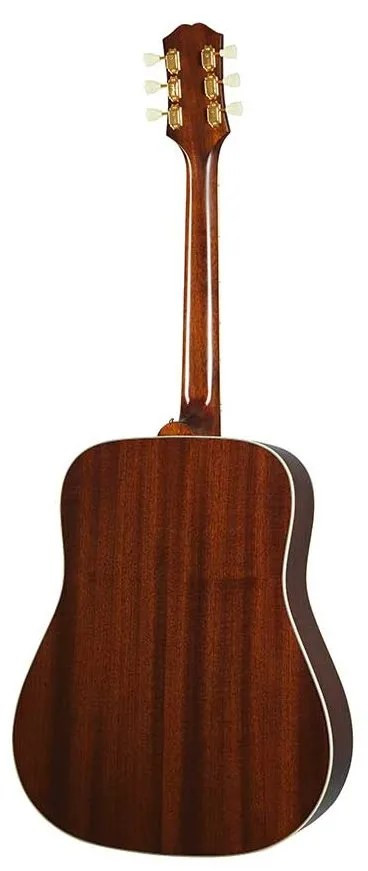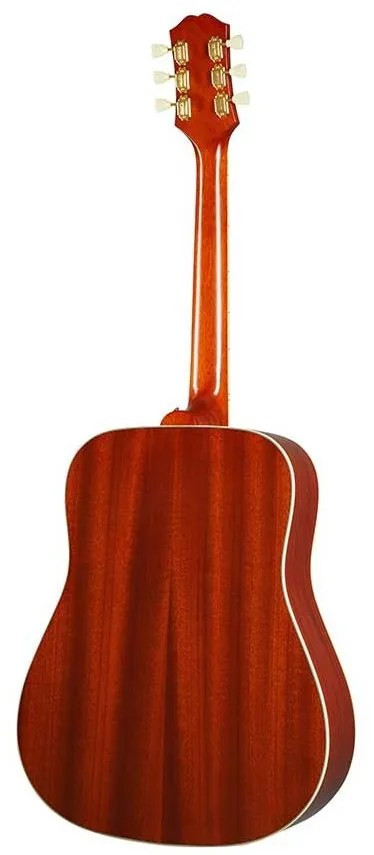The Gibson Hummingbird is legendary, a square-shouldered dreadnought acoustic guitar admired for over half a century. From rock icons like Keith Richards to country stars like Sheryl Crow, its distinctive look and sound have graced countless stages and recordings. For many guitarists, owning a Hummingbird is a dream, but its premium price point can be a barrier.
Enter the Epiphone Inspired by Gibson Hummingbird, a guitar that captures the essence of the iconic Hummingbird at a fraction of the cost. While vintage Gibson Hummingbirds can command prices from $3,250 to nearly $10,000 on platforms like Reverb.com, and even new Gibson models like the Historic 1960 Hummingbird or Hummingbird Original range from $3,800 to $5,000, the Epiphone version retails for just $799. This remarkable price difference makes the dream of owning a “Hummingbird Guitar” accessible to a much wider range of players, without significantly compromising on the vibe and quality of its Gibson counterpart. Having spent time playing the Epiphone Hummingbird, it’s clear that this guitar offers incredible value and inspiration.
 Epiphone Hummingbird natural back
Epiphone Hummingbird natural back
Delving into the Details of the Epiphone Hummingbird
The formula for the Hummingbird guitar, established by Gibson in 1960, is relatively straightforward yet highly effective. The core components include a solid Sitka spruce top for resonant clarity, mahogany back and sides for warmth and richness, and a visually striking cherry sunburst or natural finish. The Epiphone Inspired by Gibson Hummingbird faithfully adheres to this classic recipe.
Superficially, the differences between the Epiphone and its Gibson inspiration are subtle. The nut width on the Epiphone is just a hair narrower at 1.69 inches compared to the Gibson’s 1.72 inches, a barely noticeable difference for most players. Epiphone utilizes Indian laurel for the fretboard and bridge instead of rosewood, and opts for a durable polyurethane finish rather than the more traditional nitrocellulose lacquer.
However, Epiphone has meticulously preserved many of the details that make the Gibson Hummingbird so recognizable and desirable. The iconic Hummingbird pickguard with its floral and hummingbird design is present and beautifully executed. The classic mother-of-pearl split parallelogram fretboard inlays add a touch of vintage elegance. Epiphone Deluxe tuners, complete with gold press-in bushings and Kluson-style tulip pegs, contribute to both the guitar’s aesthetic and tuning stability.
The review model featured an Aged Antique Natural finish, a subtly ambered hue with a gently aged patina, which is also available in the equally appealing Aged Cherry Sunburst. Beyond its visual appeal, the Epiphone Hummingbird impresses with its build quality. The internal bracing is clean and precise, and the overall construction feels solid and resonant. This is an all-solid-wood guitar that delivers the tactile and sonic experience you’d expect from such an instrument.
Playability and Sound Quality of the Epiphone Hummingbird
Moving beyond specifications, the true test of any guitar lies in its playability and sound. The Epiphone Hummingbird review model arrived in excellent setup condition directly from the factory, strung with Gibson phosphor bronze strings (.012–.053 gauge). The guitar played effortlessly across the entire neck, a testament to improved quality control across Epiphone’s production. Previous Epiphone Hummingbird iterations may not have consistently offered this level of out-of-the-box playability, highlighting a positive shift in quality under Gibson’s current direction.
Playing cowboy chords on the Hummingbird reveals a rich and full sound, characterized by a shimmering high-end and a well-balanced, substantial low-end. The guitar responds beautifully to various playing styles. Double-stops and single-note lines played higher up the neck exhibit a sweet and articulate character. The neck profile is comfortable and accommodating, offering ample room for movement, and surprisingly, string squeak is minimal. Even powerful barre chords ring out with clarity and authority.
While it may not possess the same depth and complexity as a high-end instrument like a Lowden, the Epiphone Hummingbird excels in fingerstyle playing, particularly for folk, blues, and Celtic genres, projecting a bold and articulate voice.
 Epiphone Hummingbird cherry burst back
Epiphone Hummingbird cherry burst back
Given its accessible price point, the Epiphone Hummingbird is equipped with the popular Fishman Sonitone undersaddle piezo pickup system. While functional and widely used, players seeking more nuanced amplified tones might consider exploring alternative pickup options. However, for live performance, the Hummingbird projects remarkably well acoustically, even capturing the delicate nuances of the higher strings when recorded with a microphone like a Rode NT1-A in a studio setting.
The Epiphone Hummingbird: A True Song Machine
Beyond specs and build quality, the most crucial aspect of any acoustic guitar is its ability to inspire creativity. The Epiphone Inspired by Gibson Hummingbird excels in this intangible quality. Within days of receiving the review model, the author found themselves writing several new songs, a testament to the guitar’s inspiring nature.
This is an instrument that you’ll be drawn to visually and, more importantly, compelled to pick up and play frequently. The best advice is to experience both a Gibson Hummingbird and this Epiphone model firsthand. Set aside price considerations initially and simply determine which guitar ignites your musical passion. You might be surprised to find that the Epiphone Hummingbird, with its exceptional value, not only fuels your creativity but also lightens the financial burden, making the dream of owning a “hummingbird guitar” a tangible reality.
Epiphone Hummingbird Specifications
Body: 14-fret square-shouldered dreadnought shape; Solid Sitka spruce top with quartersawn spruce bracing; Solid mahogany back and sides; Reverse belly Indian laurel bridge with bone saddle; Top and back multi-ply binding; Tortoise pickguard with Hummingbird graphics; Aged gloss finish (Cherry Sunburst or Antique Natural)
Neck: 24.72″ scale mahogany neck with rounded C profile; Glued-in tapered dovetail joint; Dual-action truss rod; 20 medium jumbo frets; Indian laurel fretboard with 12.01″ radius and mother-of-pearl split parallelogram inlays; 1.69″ bone nut; Epiphone Deluxe tuners with gold press-in bushings
Electronics: Fishman Sonitone electronics
Strings: Gibson phosphor bronze strings (.012–.053)
Case: Optional EpiLite case ($90)
Left-handed option: Available
Made In: Indonesia
Price: $799 street
Website: epiphone.com
